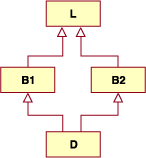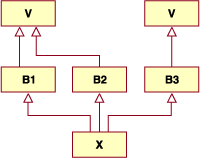
Suppose you have two derived classes B and C that have a common base class A, and you also have another class D that inherits from B and C. You can declare the base class A as virtual to ensure that B and C share the same subobject of A.
In the following example, an object of class D has two distinct subobjects of class L, one through class B1 and another through class B2. You can use the keyword virtual in front of the base class specifiers in the base lists of classes B1 and B2 to indicate that only one subobject of type L, shared by class B1 and class B2, exists.
For example:

class L { /* ... */ }; // indirect base class
class B1 : virtual public L { /* ... */ };
class B2 : virtual public L { /* ... */ };
class D : public B1, public B2 { /* ... */ }; // validUsing the keyword virtual in this example ensures that an object of class D inherits only one subobject of class L.
A derived class can have both virtual and nonvirtual base classes. For example:

class V { /* ... */ };
class B1 : virtual public V { /* ... */ };
class B2 : virtual public V { /* ... */ };
class B3 : public V { /* ... */ };
class X : public B1, public B2, public B3 { /* ... */
};In the above example, class X has two subobjects of class V, one that is shared by classes B1 and B2 and one through class B3.
Related information